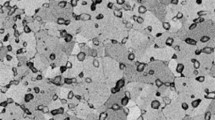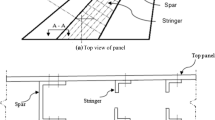Abstract
The aims of the work were first to obtain the fatigue crack growth and life numerically and empirically and then compare the numerical results and experimental data. Grade 1 titanium plates with both symmetrically and anti-symmetrically waisted cracks were due to tension tests first to receive the load versus displacement diagrams and mechanical properties of strength and stiffness. Next from cyclic tests the load versus cycles curves were constructed and fatigue life obtained. The numerical analysis using finite element method and ANSYS workbench was to yield the numerical results of crack growth and life. From fracture mechanics, the critical crack length was considered as final failure, and then, the modified numerical results were received. The estimated crack growth rates showed that at high load ratios the rates were faster and the lives shorter; however, at low load rations both were reverse. The results in load versus cycles curves from two numerical method were found within acceptable errors with the experimental data.











Similar content being viewed by others
Data availability
The datasets generated during and/or analyzed during the current study are available from the corresponding author on reasonable request.
References
Wang DA, Pan J (2005) A computational study of local stress intensity factor solutions for kinked cracks near spot welds in lap-shear specimens. Int J Solids Struct 42:6277–6298. https://doi.org/10.1016/j.ijsolstr.2005.05.036
Yan Y (2006) Stress intensity and propagation of mixed-mode cracks. Eng Fail Anal 13:1022–1027. https://doi.org/10.1016/j.engfailanal.2005.04.007
Sinha S, Ghosh S (2006) Modeling cyclic ratcheting based fatigue life of HSLA steels using crystal plasticity FEM simulations and experiments. Int J Fatigue 28:1690–1774. https://doi.org/10.1016/j.ijfatigue.2006.01.008
Richard HA, Sander M, Fulland M, Kullmer G (2008) Development of fatigue crack growth in real structures. Eng Fract Mech 75:331–340. https://doi.org/10.1016/j.engfracmech.2007.01.017
Singh IV, Mishra BK, Bhattacharya S, Patil RU (2012) The numerical simulation of fatigue crack growth using extended finite element method. Int J Fatigue 38:109–119. https://doi.org/10.1016/j.ijfatigue.2011.08.010
Jha SK, John R, Larsen JM (2013) Incorporating small fatigue crack growth in probabilistic life prediction: effect of stress ratio in Ti–6Al–2Sn–4Zr–6Mo. Int J Fatigue 51:83–95. https://doi.org/10.1016/j.ijfatigue.2013.01.008
Kumar S, Singh IV, Mishra BK (2015) A homogenized XFEM approach to simulate fatigue crack growth problems. Comput Struct 150:1–22. https://doi.org/10.1016/j.compstruc.2014.12.008
Grbovic A, Rasuo B (2012) FEM based fatigue crack growth predictions for spar of light aircraft under variable amplitude loading. Eng Fail Anal 26:50–64. https://doi.org/10.1016/j.engfailanal.2012.07.003
Petrasinovic D et al (2012) Extended finite element method (XFEM) applied to aircraft duralumin spar fatigue life estimation. Tech Gaz 19(3):557–562
Grbovic AM (2011) Simulation of crack propagation in titanium mini dental implants (MDI). FME Trans 39(4):165–170
Shlyannikov VN, Ishtyryakov IS (2019) Crack growth rate and lifetime prediction for aviation gas turbine engine compressor disk based on nonlinear fracture mechanics parameters. Theor Appl Fract Mech 103:102313. https://doi.org/10.1016/j.tafmec.2019.102313
Li Z, Wang X, Wang J, Lu Y, Shoji T (2020) High cycle fatigue behavior and numerical evaluation of Alloy 690TT steam generator tube. Int J Fatigue 137:105662. https://doi.org/10.1016/j.ijfatigue.2020.105662
Grbovic A, Rasuo B (2015) Use of modern numerical methods for fatigue life predictions. Recent trends in fatigue design. Nova Science Publishers Inc, New York
Saber A, Shariati M, Nejad RM (2020) Experimental and numerical investigation of effect of size, position and geometry of some cutouts on fatigue life and crack growth path on AISI1045 steel plate. Theor Appl Fract Mech 10:102506. https://doi.org/10.1016/j.tafmec.2020.102506
Gori Y, Verma RP, Kumar A, Patil PP (2021) FEA based fatigue crack growth analysis. Mater Today Proc 46:10575–10581. https://doi.org/10.1016/j.matpr.2021.01.319
Bang DJ, Ince A, Oterkus E, Oterkus S (2021) Crack growth modeling and simulation of a peridynamic fatigue model based on numerical and analytical solution approaches. Theor Appl Fract Mech 114:103026. https://doi.org/10.1016/j.tafmec.2021.103026
Kastratovic G et al (2018) Approximate determination of stress intensity factor for multiple surface cracks. FME Trans 4(1):39–45
Kim HK, Lee SB (1996) Stress intensity factors of an oblique edge crack subjected to normal and shear tractions. Theo Appl Fract Mech 25:147–154. https://doi.org/10.1016/0167-8442(96)00017-1
Shivankar S, Chen J, Liu Y (2022) Subcycle fatigue crack growth and equivalent initial flaw size model for fatigue life assessment under arbitrary loadings for Al-7075. Int J Fatigue 156:106685. https://doi.org/10.1016/j.ijfatigue.2021.106685
Xu Z, Xie W (2021) Phase-field model for brittle fracture based on the inner-element edge-based smoothed finite method (IES-FEM). Eng Fract Mech 254:107919. https://doi.org/10.1016/j.engfracmech.2021.107919
Raftopoulos DD, Farahmand B (1981) Determination of mode I and II stress intensity factors for oblique single edge cracks subjected to tension. Eng Fract Mech 14(4):763–778. https://doi.org/10.1016/0013-7944(81)90089-8
Petrasinovic N et al (2017) Aircraft duraluminum wing spar fatigue testing. FME Trans 45(4):531–536. https://doi.org/10.5937/fmet1704531P
Munoz S, Proudhon H, Dominguez J, Fouvry S (2006) Prediction of the crack extension under fretting wear loading conditions. Int J Fatigue 28:1769–1779. https://doi.org/10.1016/j.ijfatigue.2006.01.002
Ayatollahi MR, Razavi SMJ, Yahya MY (2015) Mixed mode fatigue crack initiation and growth in a CT specimen repaired by stop hole technique. Eng Fract Mech 145:115–127. https://doi.org/10.1016/j.engfracmech.2015.03.027
Rozumek D, Marciniak Z, Lesiuk G, Correia JA, de Jesus AM (2018) Experimental and numerical investigation of mixed mode I + II and I + III fatigue crack growth in S355J0 steel. Int J Fatigue 113:160–170. https://doi.org/10.1016/j.ijfatigue.2018.04.005
Pan X, Su H, Sun C, Hong Y (2018) The behavior of crack initiation and early growth in high-cycle and very-high-cycle fatigue regimes for a titanium alloy. Int J Fatigue 115:67–78. https://doi.org/10.1016/j.ijfatigue.2018.03.021
Sajith S, Murthy KSRK, Robi PS (2020) Experimental and numerical investigation of mixed mode fatigue crack growth models in aluminum 6061–T6. Int J Fatigue 130:105285. https://doi.org/10.1016/j.ijfatigue.2019.105285
Shlyannikov V, Fedotova D (2021) Distinctive features of crack growth rate for assumed pure mode II conditions. Int J Fatigue 147:106163. https://doi.org/10.1016/j.ijfatigue.2021.106163
Jones R, Lang J, Papyan V, Peng D, Lua J, Ang A (2021) Characterising crack growth in commercially pure titanium. Eng Fail Anal 122:105287. https://doi.org/10.1016/j.engfailanal.2021.105287
Fageehi YA (2021) Fatigue crack growth analysis with extended finite element for 3D linear elastic material. Metals 11:397. https://doi.org/10.3390/met11030397
Alshoaibi AM (2021) Numerical modeling of crack growth under mixed-mode loading. Appl Sci 11:2975. https://doi.org/10.3390/app11072975
Alshoaibi AM, Fageehi YA (2022) 3D modelling of fatigue crack growth and life predictions using ANSYS. Ain Shams Eng J 13:101636. https://doi.org/10.1016/j.asej.2021.11.005
Fageehi YA (2022) Prediction of fatigue crack growth rate and stress intensity factors using the finite element method. Adv Mater Sci Eng 2022:2705240. https://doi.org/10.1155/2022/2705240
Gross D, Seelig T (2006) Fracture mechanisms: with an introduction to micromechanics, 1st edn. Springer, Germany
Jen MHR, Yang JM, Tseng YH, Wu YH (2022) Fatigue failure of hybrid nanocomposite laminates with kinked single- and double-edged cracks. Theor Appl Fract Mech 121:103473. https://doi.org/10.1016/j.tafmec.2022.103473
Acknowledgements
The authors would like to gratefully acknowledge the sponsorship from the Ministry of Science and Technology under the project number: MOST 109-2221-E-110-015.
Funding
This work was supported by Ministry of Science and Technology under the project number: MOST 109-2221-E-110-015.
Author information
Authors and Affiliations
Contributions
All authors contributed to the study conception and design. Material preparation, data collection and analysis were performed by M-HRJ, Y-JW, Y-HW and W-PH. The first draft of the manuscript was written by M-HRJ, and all authors commented on previous versions of the manuscript. All authors read and approved the final manuscript.
Corresponding author
Ethics declarations
Conflict of interest
The authors have no relevant financial or non-financial interests to disclose.
Additional information
Technical Editor: João Marciano Laredo dos Reis.
Publisher's Note
Springer Nature remains neutral with regard to jurisdictional claims in published maps and institutional affiliations.
Rights and permissions
Springer Nature or its licensor (e.g. a society or other partner) holds exclusive rights to this article under a publishing agreement with the author(s) or other rightsholder(s); author self-archiving of the accepted manuscript version of this article is solely governed by the terms of such publishing agreement and applicable law.
About this article
Cite this article
Jen, MH.R., Wu, YJ., Wu, YH. et al. Numerical analysis and experimental verification on crack growth and fatigue life in double-edge cracked metal plates. J Braz. Soc. Mech. Sci. Eng. 45, 56 (2023). https://doi.org/10.1007/s40430-022-03982-1
Received:
Accepted:
Published:
DOI: https://doi.org/10.1007/s40430-022-03982-1




